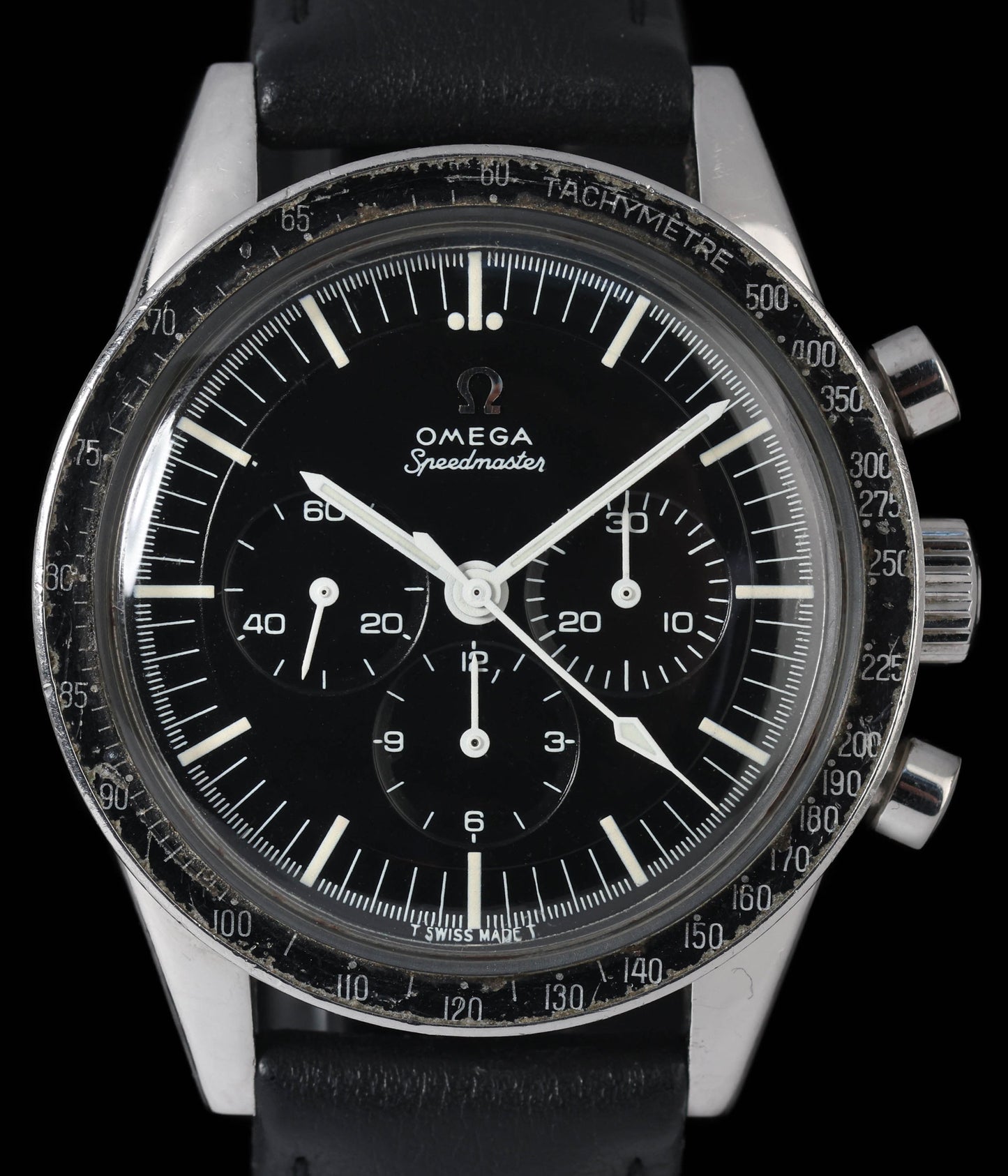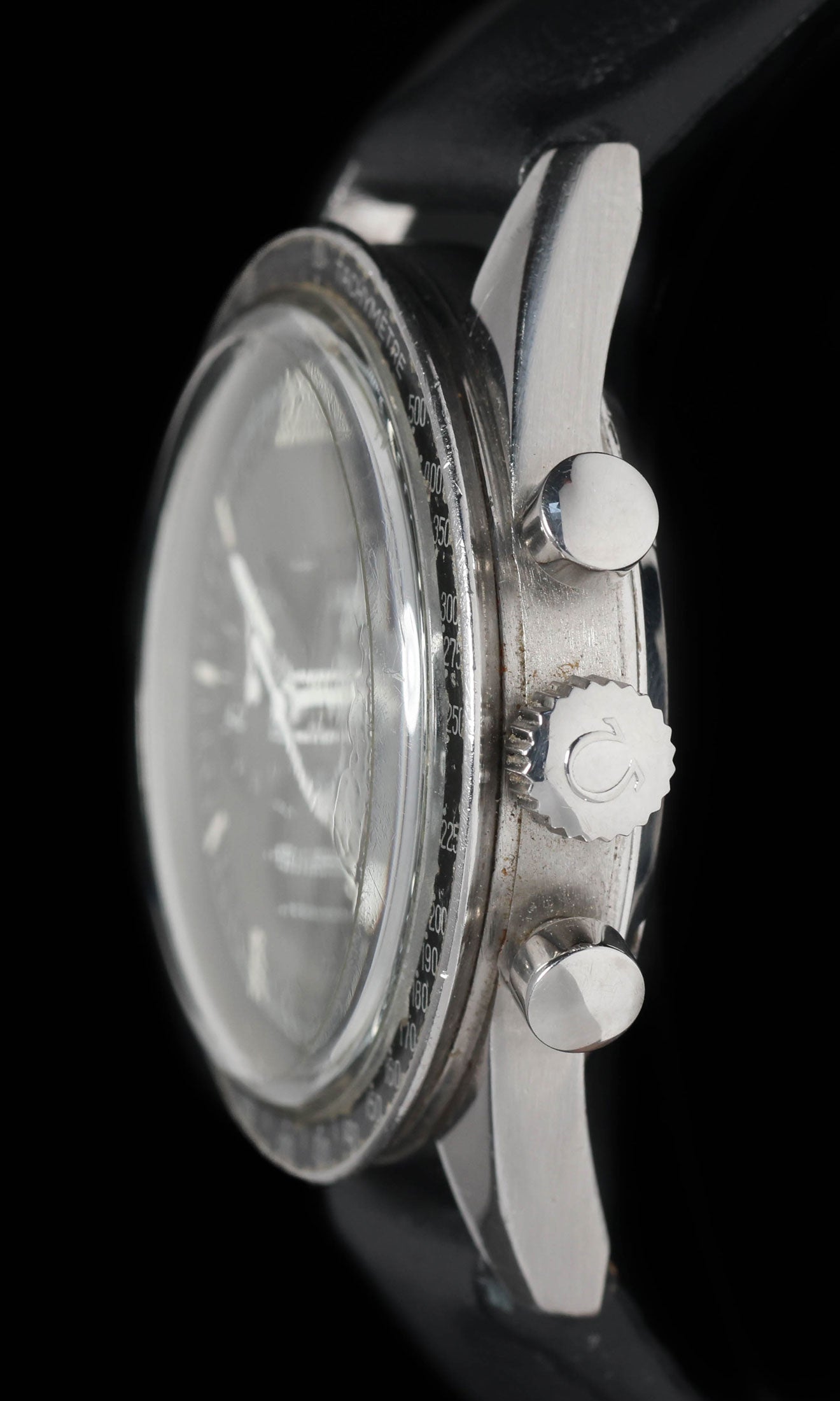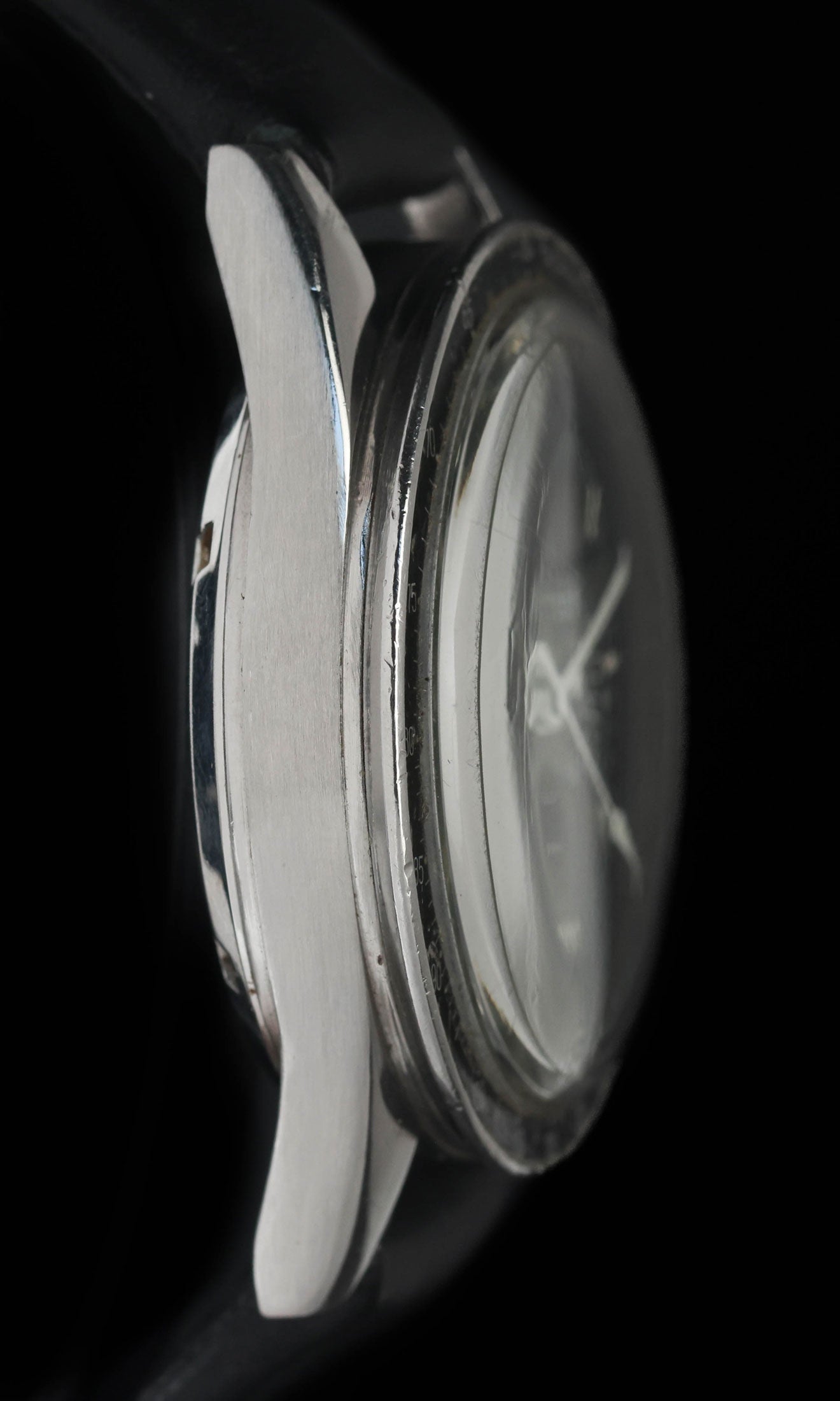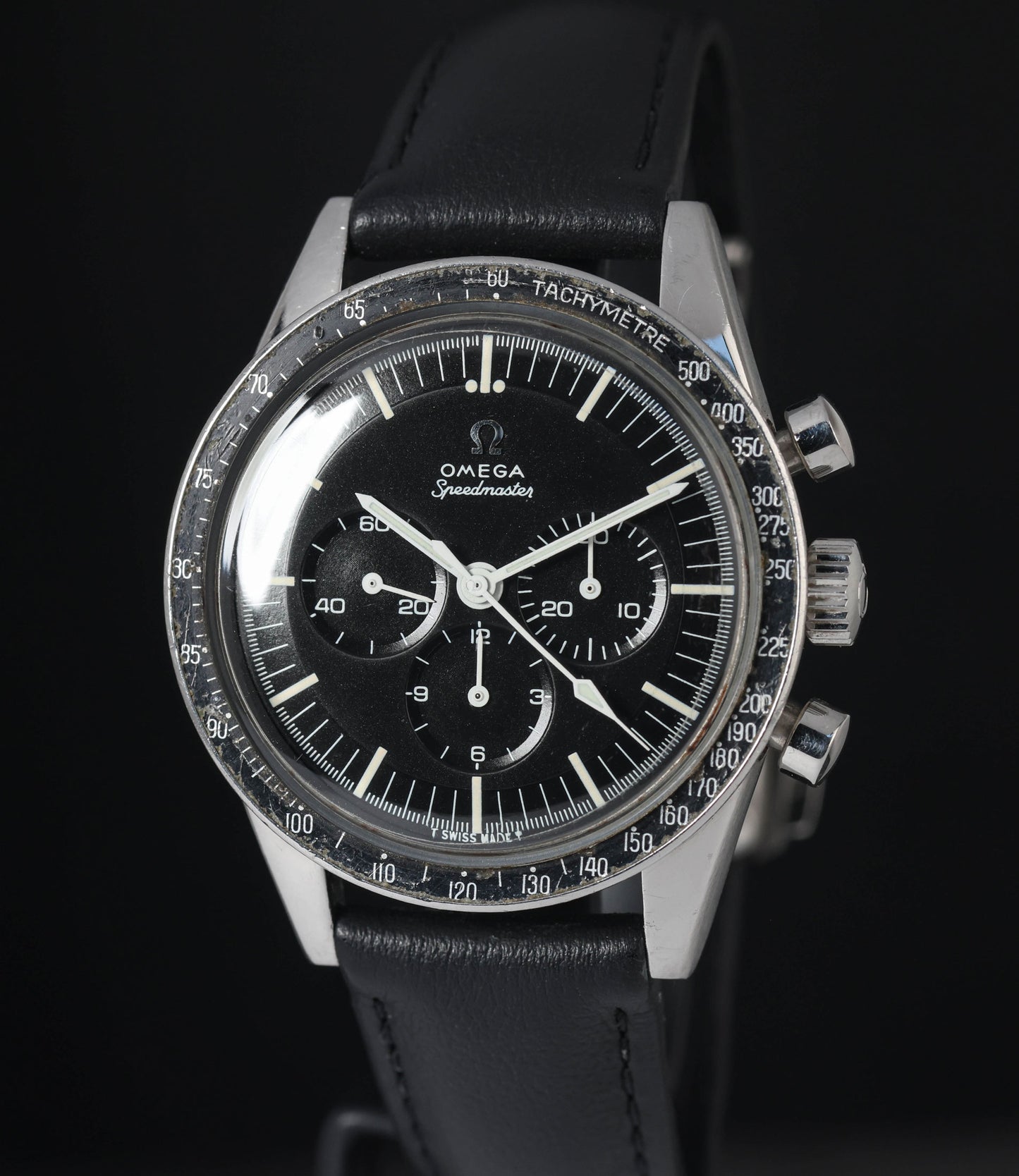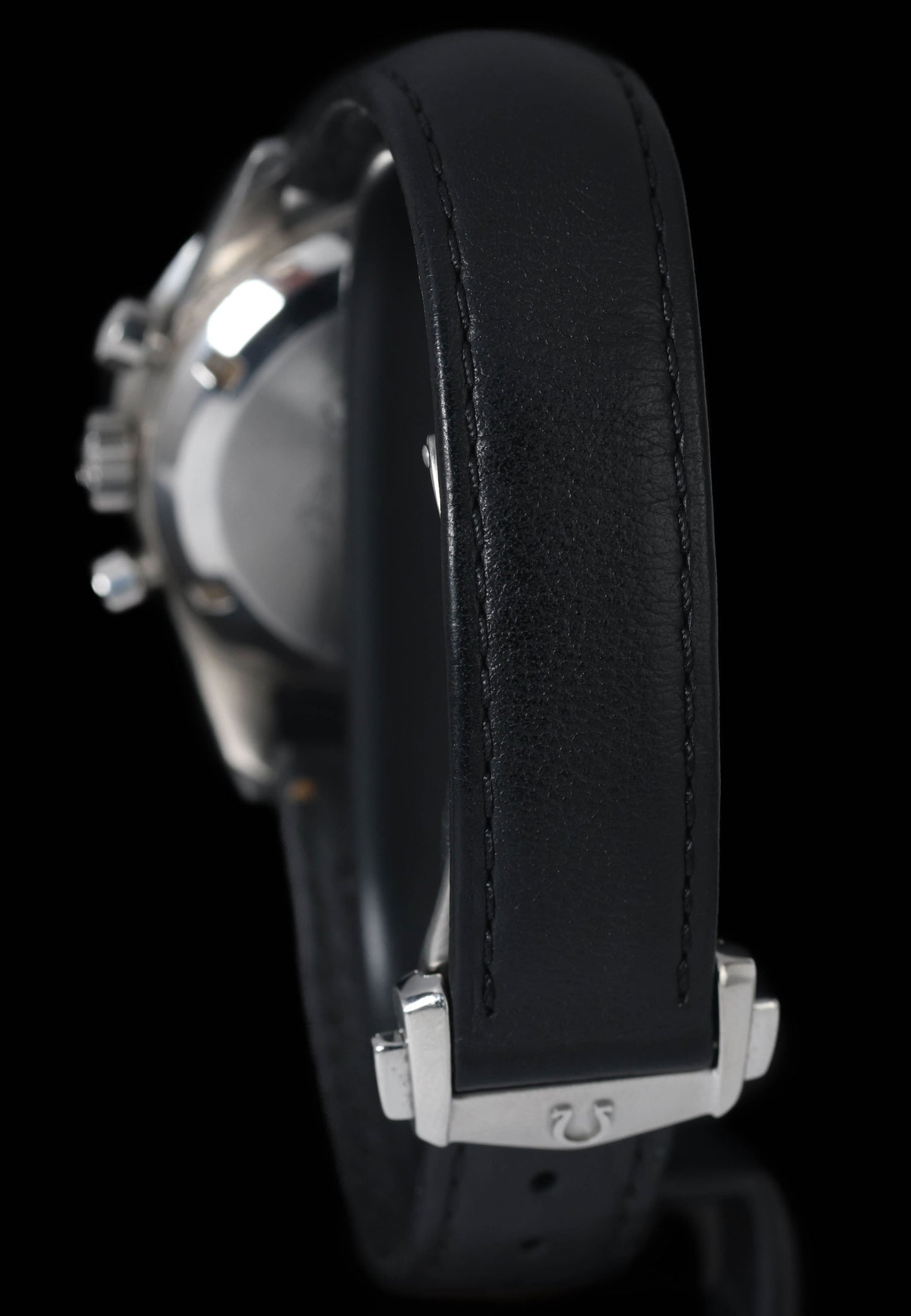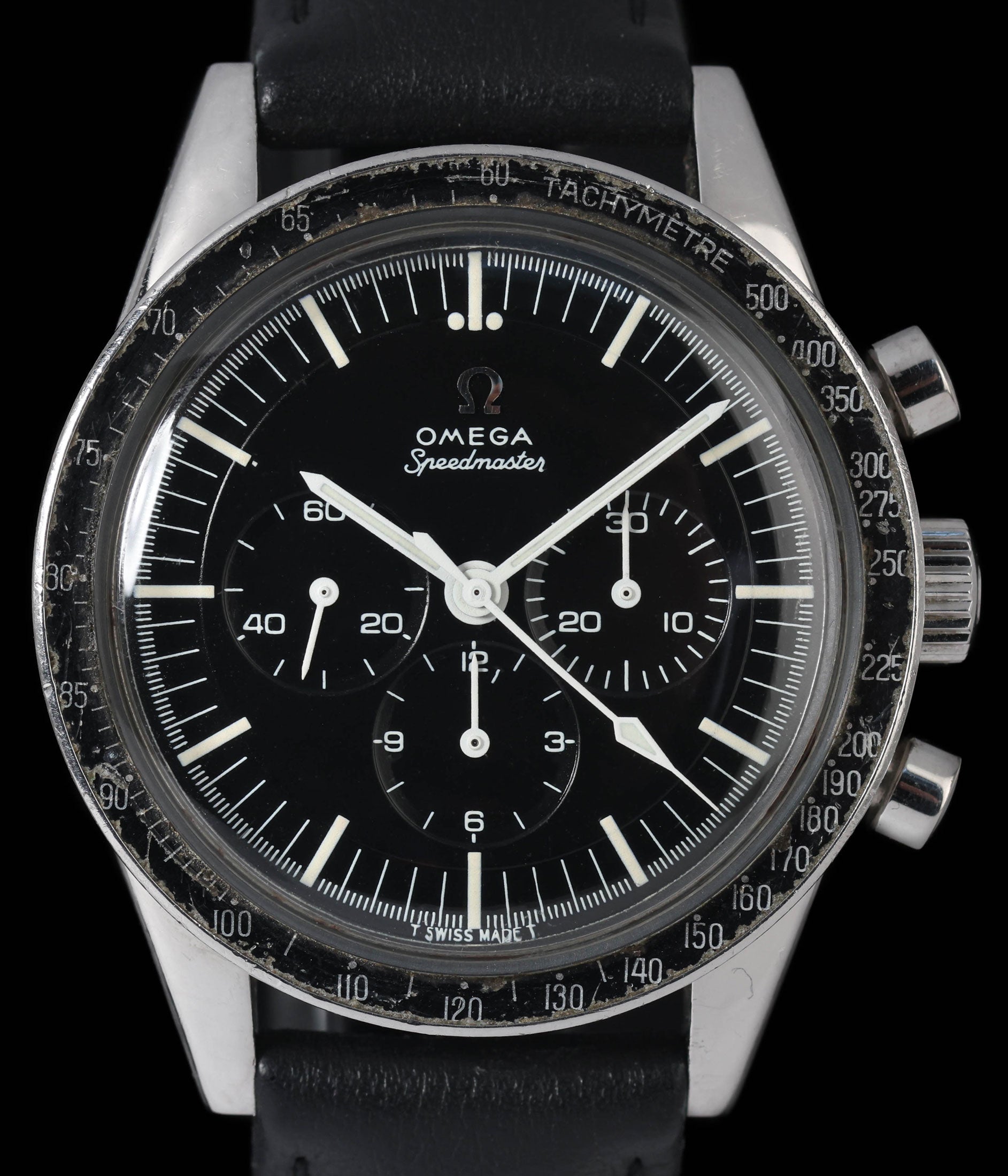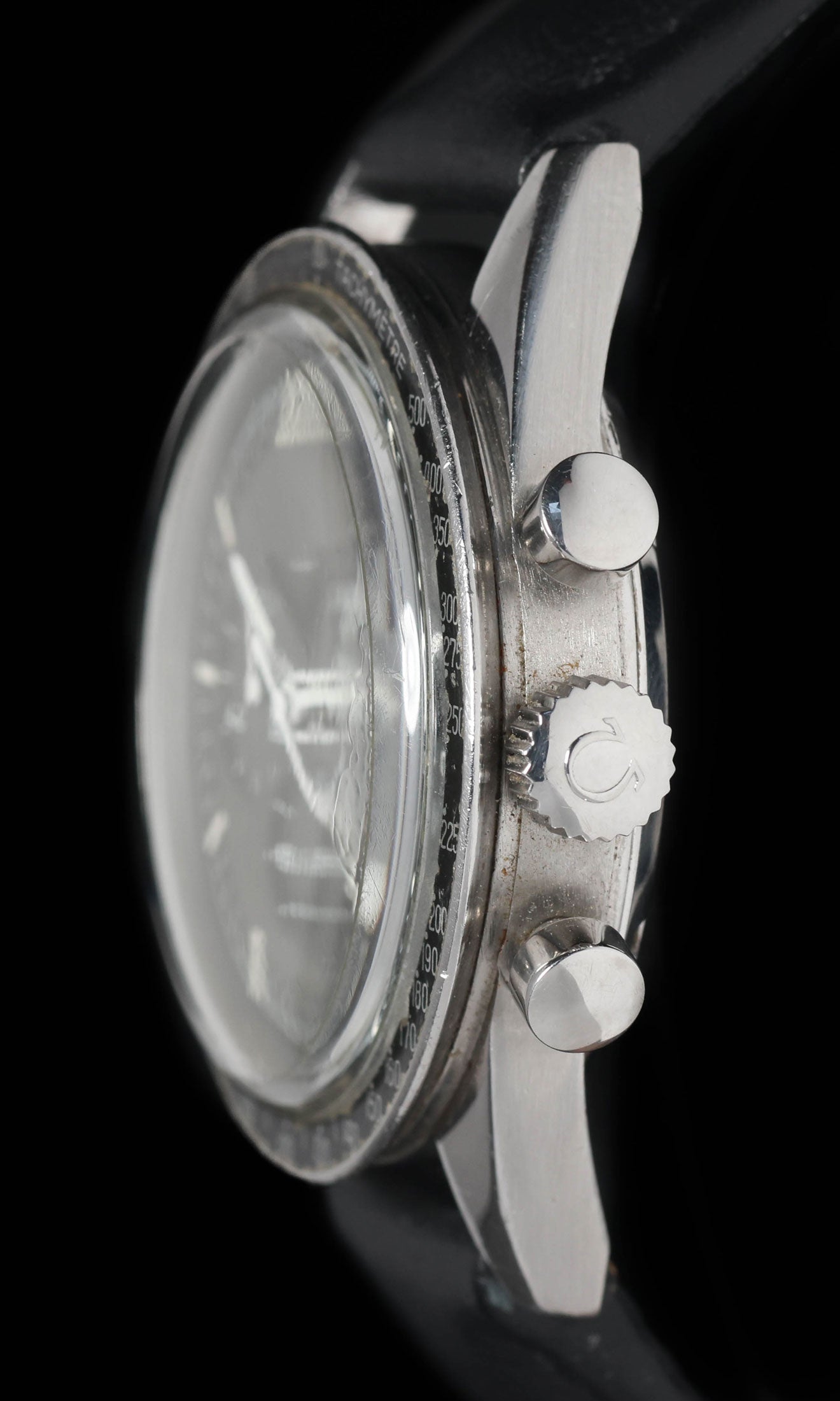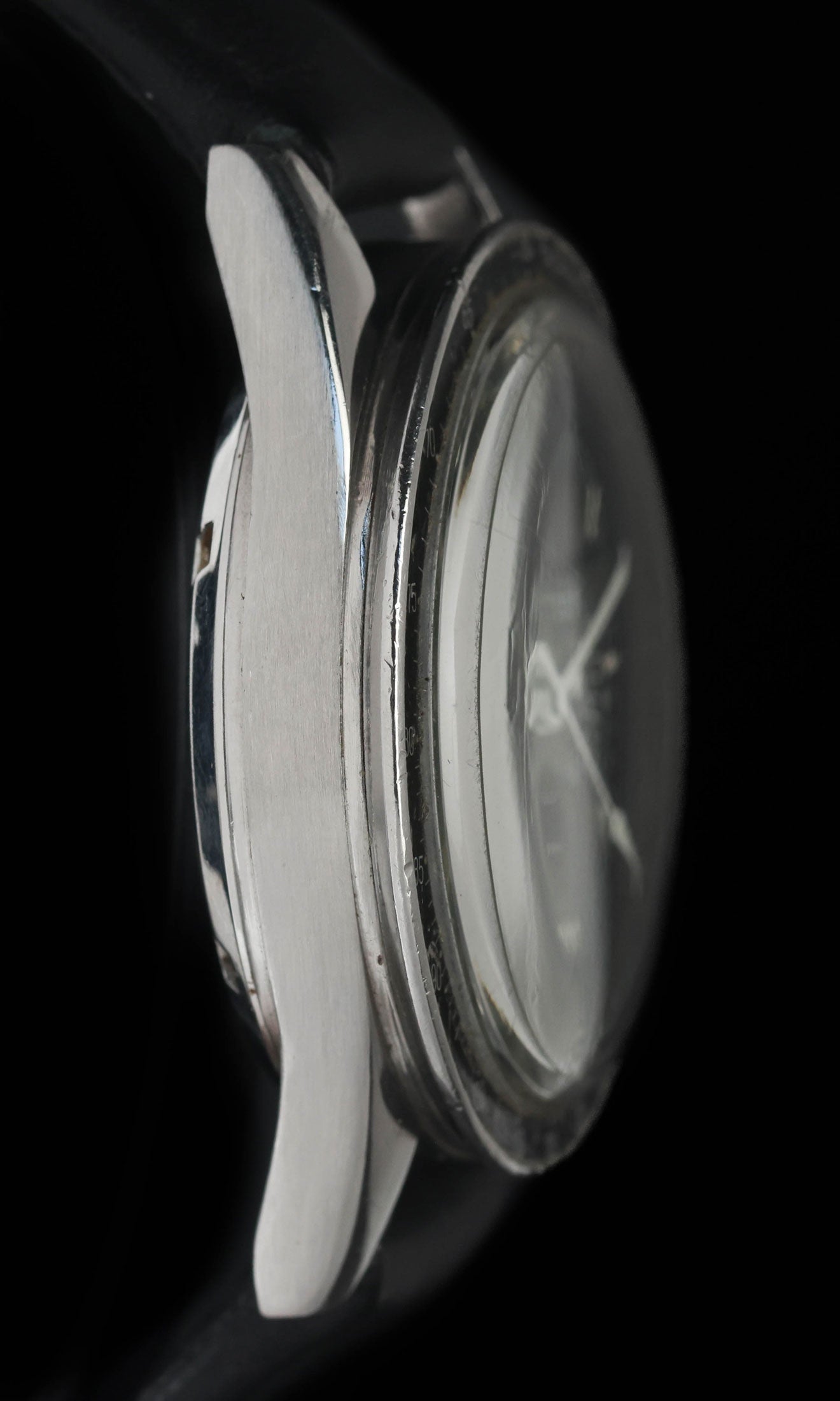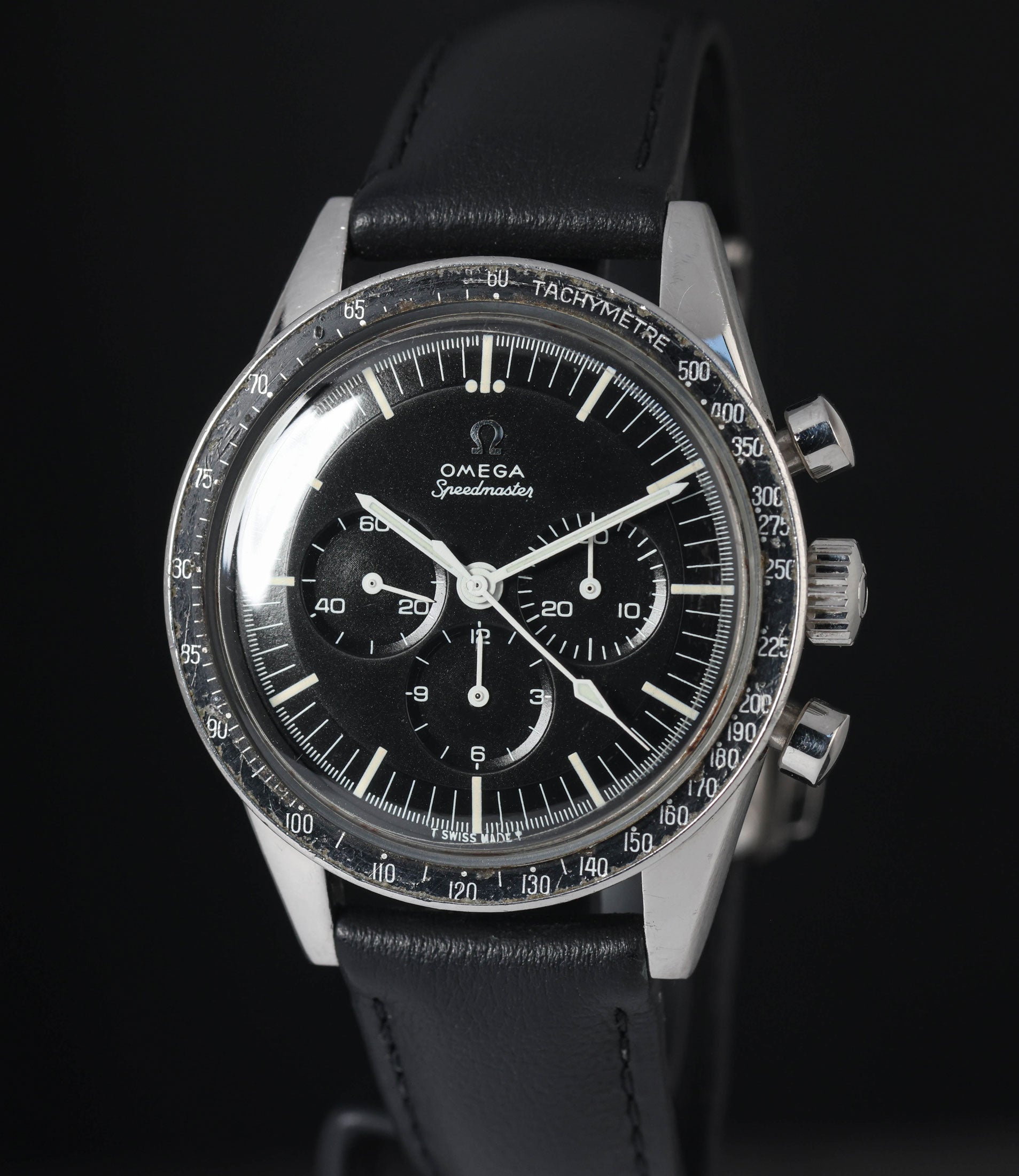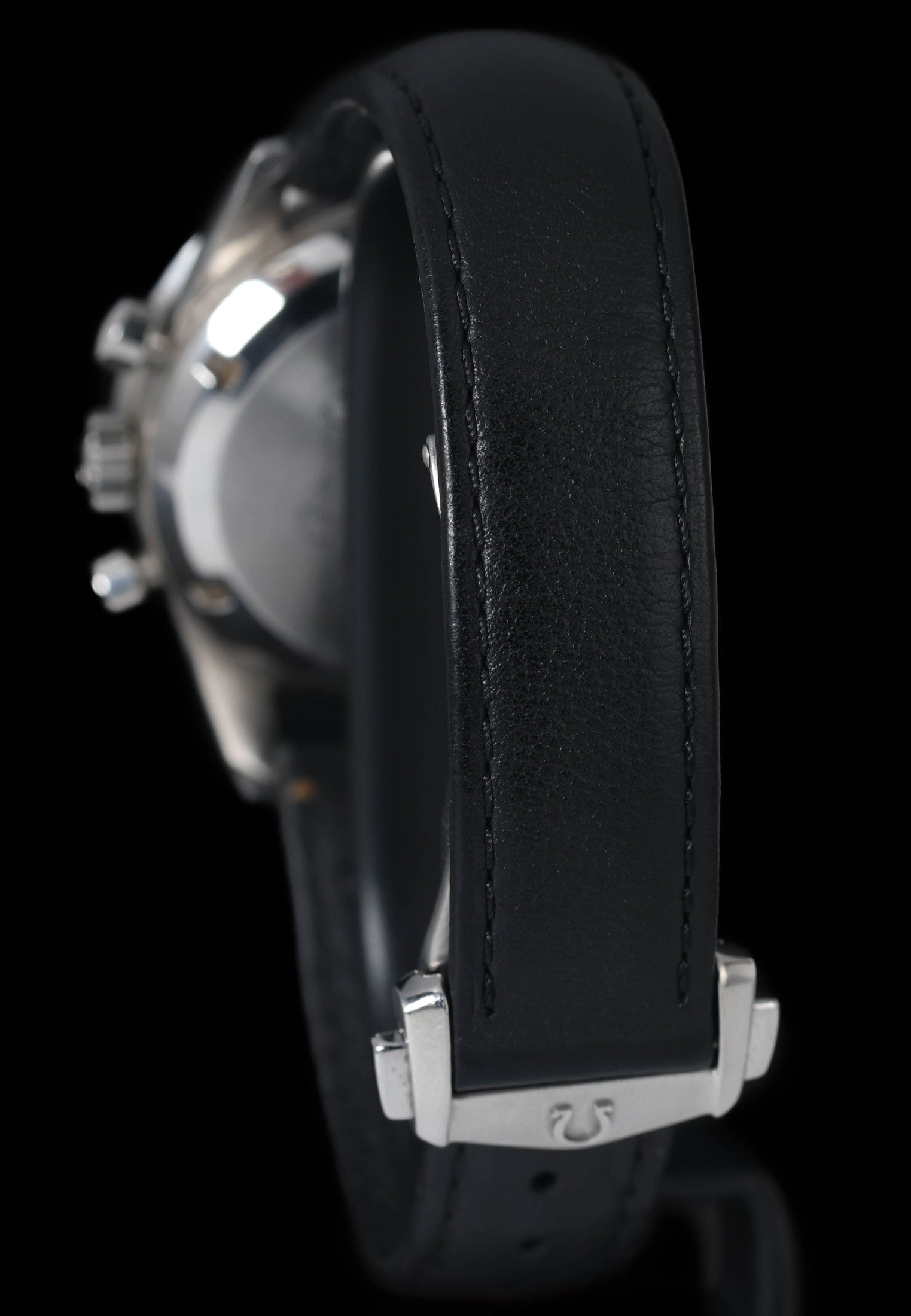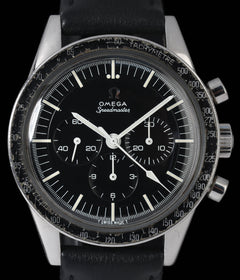Crown Vintage
Omega Speedmaster 105.003ST 'Ed White' 40mm Circa 1966
Omega Speedmaster 105.003ST 'Ed White' 40mm Circa 1966
Couldn't load pickup availability
Omega Speedmaster 105.003ST 'Ed White'
This 1966 Omega Speedmaster 105.003 ST presents as a well-preserved vintage example. The straight-lug case retains its original contours and sharp edges, showing only light hairlines and the gentle patina expected of nearly six decades of careful wear. A later-era Omega service strap with deployant clasp remains in very good condition, its stitching intact and the hardware functioning crisply. The black aluminium bezel is likewise in good vintage order, with legible numerals and only minor surface marks and fading that do not detract from its appearance. Service-replacement hands are fitted; their lume is marginally brighter than the dial plots but cleanly applied and free of corrosion. The stepped “pre-Professional” dial is in very good condition—printing is sharp, the applied Ω logo is secure, and the tritium indices have mellowed to an even sandy tone with no signs of moisture ingress. As with any Speedmaster of this age, water resistance can no longer be guaranteed; exposure to water should be avoided.
Share
Why we love this watch
Why we love this watch
Omega Speedmaster 105.003 (1966)
The Speedmaster reference 105.003 occupies a pivotal place in Omega’s chronograph lineage. Produced from 1963 to 1966, it closed the chapter on the straight-lug “pre-Professional” Speedmasters and served as the last reference to carry a dial without the word “Professional”. Its role in NASA’s Gemini programme, and particularly astronaut Ed White’s pioneering space-walk, later conferred the enduring nickname “Ed White” on every 105.003. For many collectors, a 1966 example represents the most refined and plentiful version of the straight-lug Speedy, preserving the original design language while benefitting from the incremental manufacturing tweaks Omega made over the previous three years.
Genesis of the 105.003
Omega unveiled the Speedmaster in 1957 to meet the timing needs of professional drivers, but by the early-1960s the competition among Swiss chronograph makers had intensified. References 2915, 2998 and 105.002 all introduced notable safety-oriented improvements—most conspicuously a larger bezel and, later, a higher-contrast dial. Reference 105.003 arrived in 1963 with the goal of standardising those incremental upgrades and enhancing production efficiency. Its case retained the 39.7 mm diameter but offered slimmer, more symmetrical straight lugs than its immediate predecessor, giving the watch its unmistakably compact, tool-like profile. Between 1963 and 1966 Omega produced more units of the 105.003 than of any earlier straight-lug Speedmaster, broadening global availability and, ironically, setting the stage for its future scarcity in top condition.
Straight-Lug Case and Proportions
A 105.003 from 1966 measures 39.7 mm across, spans roughly 47 mm lug-to-lug and takes 19 mm straps. Lug width aside, everything about the case is marginally more refined than on the 105.002: the chamfers terminating the lug tips are cleaner, the crown is enlarged to 7 mm for easier winding and the pump pushers grow to 4.5 × 3.5 mm—all small changes that improve handling without altering the watch’s footprint on the wrist. The double-step screw-back is engraved simply “Speedmaster” and houses a dust-cover beneath, a construction that grants basic dust and moisture protection but never true water-resistance by modern standards; any vintage example should be kept well clear of the surf.
Dial, Hands and Bezel
The 1966 dial remains a textbook “pre-Professional” layout: a matte black stepped surface, applied metal Ω logo, long tritium hour indices and the closely spaced “T SWISS MADE T” signature at six. A hesalite crystal protects the dial from parallax distortion and yields the characteristic warm glow around its edge. White baton hour and minute hands match the thin sub-dial sticks, while the central chronograph seconds hand retains the spear tip introduced on earlier references. Around the outside sits a black aluminium “BASE 500” tachymetric bezel, most 1966 pieces still featuring the coveted dot-over-90 (DON) font. The aged tritium often assumes a sandy tone, and naturally faded bezels can exhibit hues ranging from gunmetal grey to a pale ghost.
Inside: Calibre 321
At the heart of every 105.003 beats Omega’s calibre 321, a 17-jewel, column-wheel chronograph based on the Lemania 2310 architecture. Beating at 18,000 vph and offering roughly 44 hours of running autonomy, the movement combines a lateral clutch with a free-sprung balance regulated by screws, allowing precise adjustment without a regulator arm. Column-wheel actuation provides the crisp pusher feel collectors revere, and the movement’s rugged wheel teeth and over-engineered rocker arms often allow longer intervals between overhauls than later cam-lever calibres, provided the watch is exercised regularly.
NASA Qualification and Ed White Legacy
In late 1964 NASA tested chronographs from Longines-Wittnauer, Rolex and Omega under eleven punishing conditions that simulated launch, vacuum and orbital extremes. Only the Speedmaster survived intact, and on 1 March 1965 the reference ST 105.003 received formal approval for manned missions. When Ed White stepped from Gemini IV’s hatch on 3 June 1965, the straight-lug Speedmaster strapped over his Gemini G4C spacesuit was an essentially standard 105.003-65, instantly validating the reference’s durability and elevating it from driver’s instrument to aerospace tool. NASA continued issuing 105.003 watches to Gemini crews until supplies ran out, after which the asymmetrical-cased 105.012 and 145.012 became standard for Apollo.
1966 Production Nuances
Most 1966 examples carry the case-back suffix “-65” despite leaving Bienne a year later, confirming Omega’s practice of exhausting existing case supplies before issuing updated stampings. Serial ranges typically fall in the mid-24 million band, though factory delays mean some extracts show delivery as late as 1969. Small-batch changes mark the final batches: a slightly taller applied Ω logo, marginally wider dial text and, on a minority of pieces, a transitional DON bezel with bolder numerals. These late details let specialists date un-papered watches and partly explain why seemingly identical 105.003s can command different premiums.
Collectability and Market Context
Because the 105.003 is the most abundant straight-lug Speedmaster, condition trumps rarity. Crisp, unpolished lugs with intact bevels, a clean step dial free of moisture spots and an original DON bezel collectively define the top tier. On today’s market an “Excellent” 1966 example with bracelet, box and extract can fetch AUD 34,000–42,000, whereas a tired but honest head-only watch may sell for half that. The broad spread is mirrored by auction results ranging from sub-AUD 10,000 for compromised pieces to six-figure outliers for exceptional provenance. Values have risen steadily since Omega relaunched the calibre 321 in 2020; each factory re-edition seems to rekindle interest in the watch that inspired it.
Wearing and Servicing a 105.003 Today
At 39.7 mm across and 13.5 mm thick, the reference sits lower than later “Professional” cases and hugs the wrist comfortably, helped by the vintage bracelet’s small-span links. Modern-day owners often fit flat-link reproduction bracelets or soft leather straps to reduce weight, but the original 1506 or 1035 bracelet with 19 mm curved ends remains the textbook pairing. Any servicing should be entrusted to a watchmaker experienced with calibre 321 parts interchangeability—modern service stocks are improving but still limited in Australia, and sourcing a period-correct steel chronograph seconds hand or DON bezel can be a costly exercise. Routine maintenance typically involves a complete tear-down, fresh mainspring, and correct chronograph lubricant, restoring amplitude while preserving the movement’s cosmetic originality.
Advice for Prospective Buyers
Documentation drives value: an Omega Extract of the Archives confirming the serial number and a 1966 production date is the minimum due diligence. Inspect the dial under UV light for consistent tritium glow decay; mismatched handset plots or a bright creep at 12 o’clock often betray relume jobs. Check the movement’s bridge for correct asymmetric clutch and observe if the column-wheel screw shows tool marks that might indicate past part swaps. Finally, scrutinise bezel fonts: the tell-tale DON should have a flat-topped “A” in “TACHYMÈTRE” and a dot touching interior rim of the “70”, subtleties that separate original parts from modern service replacements.
Final Thoughts
A 1966 Speedmaster 105.003 is more than a precursor to the Moonwatch—it is the culmination of Omega’s first decade refining a chronograph for professionals, the watch that proved its mettle on Gemini missions, and a time-capsule of mid-1960s industrial watchmaking. Its restrained 39.7 mm straight-lug case preserves the Speedmaster’s original proportions, while the calibre 321 showcases the finest hand-wound chronograph engineering of its era. Well-bought pieces reward owners with daily-wear versatility, strong long-term liquidity and a direct, unembellished link to one of NASA’s most important tests. For collectors who value authenticity over ostentation, the 105.003 remains a compelling benchmark in the Speedmaster story—one that is still attainable, yet increasingly scarce in top, untouched condition.
Case & Bracelet
Case & Bracelet
Case in good vintage condition. Bracelet is a service Omega strap and deployment clasp in very good condition. Bezel is in fair vintage condition.
Dial & Hands
Dial & Hands
Hands appear to be service hands. Dial is in very good condition.
Warranty & Condition
Warranty & Condition
Crown Vintage Watches provides a minimum 3-month mechanical warranty on pre-owned watches, from the date of purchase.
The warranty covers mechanical defects only.
The warranty does not cover damages such as scratches, finish, crystals, glass, straps (leather, fabric or rubber damage due to wear and tear), damage resulting from wear under conditions exceeding the watch manufacturer’s water resistance limitations, and damage due to physical and or accidental abuse.
Please note, water resistance is neither tested nor guaranteed.
Shipping and insurance costs for warranty returns to us must be covered by the customer. Returns must be shipped via traceable courier. Return shipment must be pre-paid and fully insured. Collect shipping will be refused. In case of loss or damages, the customer is liable.
Our Pledge
At Crown Vintage Watches, we stand by the authenticity of every product we sell. For added peace of mind, customers are welcome to have items independently authenticated at their own expense.
Condition
Due to the nature of vintage timepieces, all watches are sold as is. We will accurately describe the current condition and working order of all watches we sell to the best of our ability.
Shipping & Refund
Shipping & Refund
